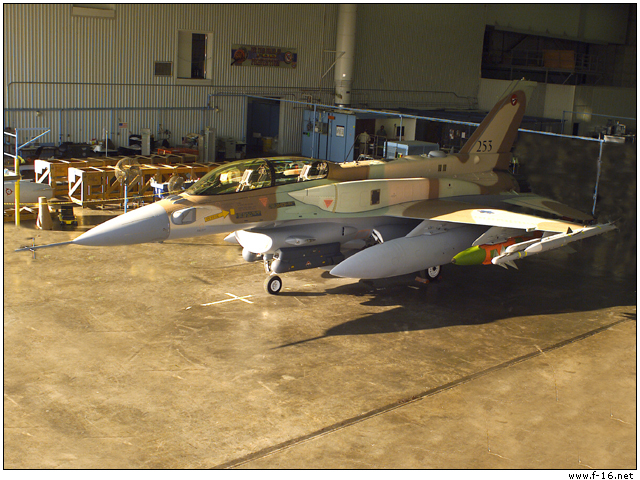Fighter Jet News
F-16 Fighting Falcon News
First F-16I Sufa ready for delivery to Israel
November 26, 2003 (by
F16VIPER) -
The long-awaited Israeli F-16I Sufa ('Storm') rolled off Lockheed Martin's production line in Texas.It is the first of 102 ordered by Israel in 1997. The estimated $4.5 billion dollar F-16I deal will be financed by the annual U.S. military aid package and concludes the largest Israeli military purchase in history.
The F-16I is a heavily modified two seat version of the F-16D Block 50/52. In addition to the new and more powerful Pratt & Whitney F100-PW-229 engine, the F-16I boasts numerous internal and external advancements and modifications.The Sufa has for example been customized with new avionic technologies, internally mounted FLIR (forward looking infrared) viewers, and cutting edge weapon system hardware provided by the Israeli defense company Lahav - a division of Israel Aircraft Industries.
The Lahav technology will allow for simultaneous, multi-target air-to-air engagement and increased standoff and survivability capabilities. The F-16I has been earmarked to receive the new Python 5 imaging infrared-guided high agility air-to-air missile produced by Rafael. The predecessor to the Python 5, the Python 4, was by many regarded to be the most advanced heat-seeking missile in the world. The Python 5 boasts a new seeker less prone to countermeasures, lock-after-launch capabilities, and an extended operational engagement time once fired. In addition, the Northrop Grumman AN/APG-68(V)9 multimode radar increases the distance of airborne engagement by 30 percent over the older APG-69 system and affords the "Sufa" with a high-resolution synthetic-aperture ground mapping capability.
Complementing the upgraded weapon systems is a dorsal compartment containing enhanced mission avionics and chaff and flare dispensers, enabling it to conduct either pilot training or combat missions. In addition, removable conformal fuel tanks (CFTs) have been added along the fuselage and above the wing roots, freeing-up underwing hard points for additional armaments. The F-16I has an unrefueled combat strike radius well in excess of 500 miles. The extended flight range allows Israeli forces to attack targets well within Iran and Libya without having to refuel. In addition, the cockpit of the F-16I has been expanded to provide for the addition of an onboard weapons officer situated behind the pilot.
Israel had originally ordered 50 F-16Is in 2001 but increased the purchase to 102 after deciding against the procurement of additional the more expensive twin engine Boeing F-15Is - for which the IAF placed an order for 25 in 1997. Whereas each F-15 costs approximately $84 million the cost of the F-16I is estimated at $45 million per aircraft.
The acquisition of the Sufa compliments Israel's deterrent strategy by further strengthening the threat to carry out retaliatory strikes throughout the Middle East while at the same time allowing the IAF to retire aging A-4 Skyhawks and F-4E Phantom IIs in service with the IAF since the late 1960s.
Three squadrons of the new aircraft are expected to be operational from the Ramon airbase deep inside the Negev by 2008 with the first strike aircraft arriving next month.
With the additional 102 new F-16Is, Israel will operate a total of 362 F-16s - the largest fleet of F-16s in the world outside of the United States Air Force.
Lockheed Martin will continue production at a rate of about 1.5 planes per month, and until 2008 they will send a few jets to Israel several times a year.
The Lahav technology will allow for simultaneous, multi-target air-to-air engagement and increased standoff and survivability capabilities. The F-16I has been earmarked to receive the new Python 5 imaging infrared-guided high agility air-to-air missile produced by Rafael. The predecessor to the Python 5, the Python 4, was by many regarded to be the most advanced heat-seeking missile in the world. The Python 5 boasts a new seeker less prone to countermeasures, lock-after-launch capabilities, and an extended operational engagement time once fired. In addition, the Northrop Grumman AN/APG-68(V)9 multimode radar increases the distance of airborne engagement by 30 percent over the older APG-69 system and affords the "Sufa" with a high-resolution synthetic-aperture ground mapping capability.
Complementing the upgraded weapon systems is a dorsal compartment containing enhanced mission avionics and chaff and flare dispensers, enabling it to conduct either pilot training or combat missions. In addition, removable conformal fuel tanks (CFTs) have been added along the fuselage and above the wing roots, freeing-up underwing hard points for additional armaments. The F-16I has an unrefueled combat strike radius well in excess of 500 miles. The extended flight range allows Israeli forces to attack targets well within Iran and Libya without having to refuel. In addition, the cockpit of the F-16I has been expanded to provide for the addition of an onboard weapons officer situated behind the pilot.
Israel had originally ordered 50 F-16Is in 2001 but increased the purchase to 102 after deciding against the procurement of additional the more expensive twin engine Boeing F-15Is - for which the IAF placed an order for 25 in 1997. Whereas each F-15 costs approximately $84 million the cost of the F-16I is estimated at $45 million per aircraft.
The acquisition of the Sufa compliments Israel's deterrent strategy by further strengthening the threat to carry out retaliatory strikes throughout the Middle East while at the same time allowing the IAF to retire aging A-4 Skyhawks and F-4E Phantom IIs in service with the IAF since the late 1960s.
Three squadrons of the new aircraft are expected to be operational from the Ramon airbase deep inside the Negev by 2008 with the first strike aircraft arriving next month.
With the additional 102 new F-16Is, Israel will operate a total of 362 F-16s - the largest fleet of F-16s in the world outside of the United States Air Force.
Lockheed Martin will continue production at a rate of about 1.5 planes per month, and until 2008 they will send a few jets to Israel several times a year.

